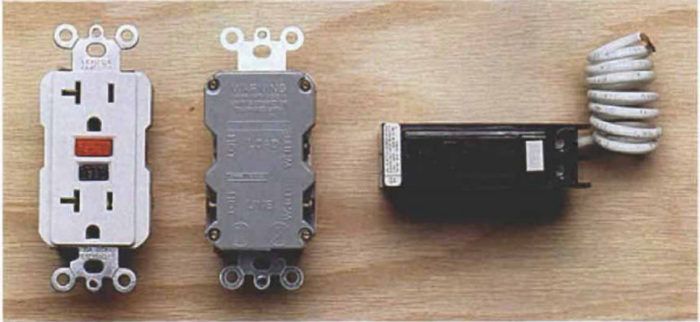Ground-Fault Protection
An inexpensive electrical device saves lives and is required by building codes.

Synopsis: A master electrician describes the operation and benefits of ground-fault protection receptacles. These are devices that protect people from potentially fatal encounters with household current.
There’s not much of a trick to electrocuting yourself while working with a power tool. Take, for instance, a builder using an electric drill outside on a clear, dry day—the drill with a frayed cord he’s been meaning to replace. The black wire in the cord, flexed once too often, could break easily and create a short circuit to the drill’s metal handle. If that were to happen, electricity would flow instantly through the builder’s hand, contracting muscles and tightening his grip on the drill. The current could continue through his body and into the ground beneath his feet, sending his heart into ventricular fibrillation, a wildly erratic rhythm. In a few minutes the builder would be dead.
An inexpensive lifesaver
This kind of pointless accident isn’t as far fetched as it may sound; it almost happened to me. But my drill was plugged into a ground-fault circuit interrupter (GFCI). Instead of being killed, I just felt a sharp jab, like a needle prick, before the GFCI shut off the current in the circuit powering my drill. The circuit breaker wouldn’t have helped; it is designed to save the wiring, not me. A 20-amp breaker won’t shut off the circuit until the current in the line exceeds 20 amps. That won’t do anything for someone grounded by a frayed wire.
GFCIs are inexpensive, easy to install and available as either receptacles or breakers. GFCI circuit breakers are designed to be installed in the main electric panel and will, if wired correctly, protect all the receptacles on the circuit. Receptacle-type GFCIs fit into a standard receptacle box and will protect any receptacle wired downstream. Some extension cords come with GFCIs already installed in them. Even some hair dryers and other appliances used in potentially wet environments now come with GFCIs in their plugs. Because older GFCIs tripped too easily, some people may have been discouraged from using them; fortunately, the new GFCIs are a lot more reliable.
How GFCIs work
Regular 120v household circuits usually consist of three wires—a black wire, a white wire and a bare neutral, or ground, wire. The two colored wires make up the circuit. Current flows through one wire (typically the black one) to the load, which is the appliance that consumes power. Then the current flows back to the source through the other wire (the white one). A GFCI compares the current flowing to the load with the current coming from the load. The current, or amperage, should be identical. If there’s a difference, the electrons must be flowing somewhere other than through the load (such as through you to ground), and the GFCI will open the circuit. GFCIs detect differences of as little as .006 amps and don’t need a grounding wire to work. A GFCI responds 1/25 to 1/30 of a second— 25 to 30 times faster than a heartbeat.
For more photos and information on how GFCIs work and where to use them, click the View PDF button below.
Fine Homebuilding Recommended Products
Fine Homebuilding receives a commission for items purchased through links on this site, including Amazon Associates and other affiliate advertising programs.

Original Speed Square

Anchor Bolt Marker

100-ft. Tape Measure


























